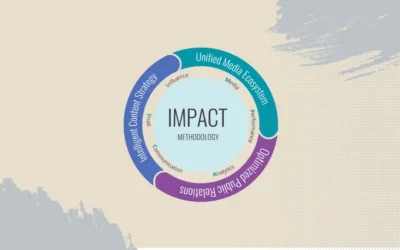Public relations have evolved from being a tactical, media-focused function into a strategic discipline essential to today’s communication ecosystem. Their true value lies in their ability to build trust, generate influence, and connect brands with their key audiences in an authentic and sustainable way.
Integrated across earned, owned, shared, and—when appropriate—paid media strategies, Optimized Public Relations (OPR) strengthen institutional storytelling, amplify brand purpose, and directly contribute to business objectives.
- Traditional PR, “a strategic communication process that builds mutually beneficial relationships between organizations and their publics”, according to the Public Relations Society of America (PRSA).
- Digital marketing, “the use of multiple digital tactics and channels to connect with consumers online where they spend most of their time” as defined by the American Marketing Association (AMA).
- SEO, which Semrush defines as “the set of processes aimed at improving your website’s visibility in search engines (like Google) to drive more organic traffic”.
With that in mind, here are some of the key benefits of public relations when applied with a long-term, strategic vision.
1. Driving brand discovery in a saturated environment
In an oversaturated information landscape, the real challenge for brands is not just being seen—it’s being discovered with credibility and relevance. Today’s public relations facilitate that discovery by positioning brands in spaces their audiences already trust: earned media, social networks, and specialized platforms.
Optimized PR strategies:
- Improve organic visibility, ensuring that the brand is found naturally through search engines and relevant content.
- Strengthen editorial presence, ensuring consistency and coherence across trusted outlets.
- Align the institutional message with audience interests, enhancing connection and relevance.
Did You Know?
60% of communication and PR leaders say that their top priority is to build sustainable growth and value for their companies (Cision & PRWeek). This underscores how PR has become a strategic engine of discovery and credibility for brands.
2. Fostering two-way and authentic communication
Today, brands don’t just communicate—they listen, respond, and evolve with their audiences. The role of public relations is to foster two-way communication that strengthens engagement and loyalty through dialogue.
Platforms such as social media, blogs, and forums have transformed how companies interact with the public. PR helps manage these conversations with agility and consistency, building genuine relationships and adapting corporate messaging to a constantly changing context.
3. Integrating into the digital marketing and communication ecosystem
Modern PR gains greater strength when integrated with digital marketing. It reinforces brand discovery and amplifies key content, creating a coherent and credible narrative across earned, owned, and shared media.
By contributing valuable content across these channels, PR enhances brand authority and directly supports business objectives through concrete and measurable outcomes.
DOWNLOAD OUR FREE EBOOK
Turn your communication into tangible results.

4. Corporate reputation: the key to attracting and retaining clients
A solid PR strategy shapes brand reputation, generating trust, credibility, and differentiation. A strong reputation not only improves institutional perception, it also facilitates customer acquisition and loyalty—while strengthening resilience in critical scenarios.
5. Strengthening relationships with stakeholders
Brands that communicate their purpose clearly forge stronger and longer-lasting connections. PR enables sustained dialogue with clients, employees, and media—an essential element for those wondering about the role of public relations in today’s world.
A brand’s purpose is not a slogan—it’s a strategic statement that guides decisions, inspires teams, and builds authentic connections with those who share that vision. This impacts reputation, culture, and loyalty in meaningful ways.
6. Elevating corporate communication from the C-suite
In B2B environments, leadership is strengthened through solid spokespersons. PR supports executives in positioning themselves as credible, visible leaders among clients, investors, and industry stakeholders—one of the clearest examples of how PR impacts business performance.
PR guides leadership in developing key messages, managing critical moments, and positioning executives around relevant industry issues. Clear, human, and purpose-driven communication builds trust and projects authority.
7. Measuring impact and demonstrating the value of public relations
Today’s PR is evaluated using strategic KPIs such as share of voice, coverage, referral traffic, and reputation. When aligned with business goals, these metrics transform PR into a strategic business pillar.
Beyond visibility, well-structured PR generates tangible value. When connected with key indicators—reputation, positioning, conversion—it becomes a measurable, results-oriented foundation for strategic communication.
The true value of public relations
The impact of PR in the B2B landscape is tangible: reputation, positioning, and sustained trust. Far from being a tactical resource, PR has become a critical tool for shaping perception and driving informed decision-making.
Its influence spans from managing public perception to positioning corporate leadership, strengthening stakeholder relationships, and integrating seamlessly with digital marketing. In the B2B context—where decision-making is complex and credibility is crucial—its value becomes even more strategic.
Ready to evolve your PR strategy and transform your brand communication?
FAQs
1. What does it mean to have optimized public relations (OPR)?
Optimized Public Relations (OPR) integrate strategic communication, digital marketing, and SEO to increase visibility, credibility, and reputation. They enable brands to be discovered organically in search engines and trusted media, connecting with key audiences within a Unified Media Ecosystem (earned, owned, shared, and paid).
2. Why are optimized public relations essential in today’s digital environment?
Because they integrate reputation, purpose, and outcomes. In an AI-driven digital environment, OPR helps brands communicate coherently, build trust, and amplify messages across multiple platforms. In doing so, PR evolves from a tactic into a strategic pillar for business growth and sustained credibility.
3. How do optimized public relations contribute to brand reputation?
OPR strengthens brand reputation through consistent messages, well-prepared spokespersons, and purpose-aligned content. This coherence builds trust, protects image at key moments, and turns reputation into a tangible, measurable asset that drives preference and differentiation in the market.
4. How is the impact of optimized public relations measured?
Impact is measured with strategic indicators such as share of voice, media coverage, backlinks, referral traffic, and digital reputation. When aligned with business goals—positioning, demand, or conversion—OPR proves its true value: driving sustainable growth and strengthening long-term brand authority.





